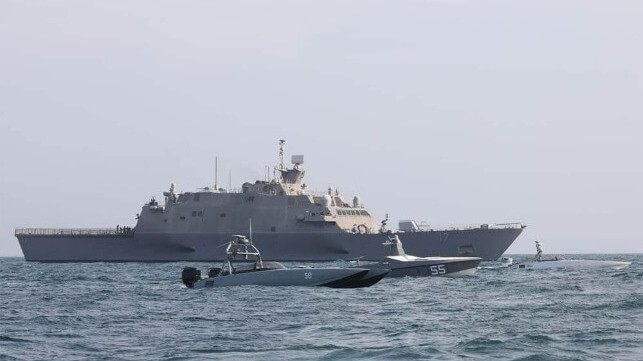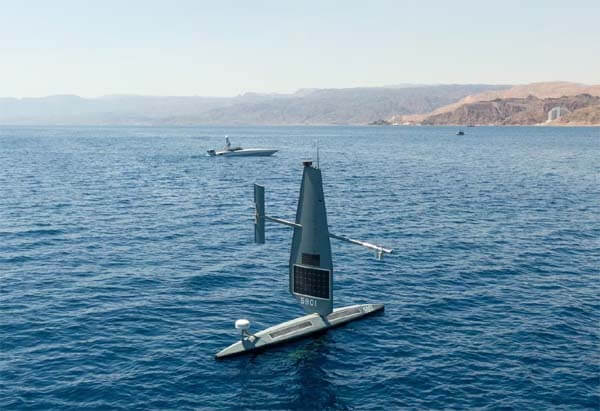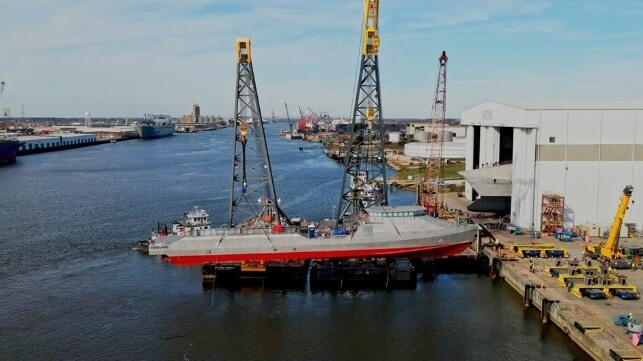USN Launches New Task Group for Uncrewed Operations in the Middle East

The US Navy reports as of the start of 2024 it has commissioned a new unit, Task Group 59.1, which focuses on the operational deployment of unmanned systems teamed with manned operators to bolster maritime security across the Middle East region. The group builds on the previous efforts developing uncrewed vessel operations in the Middle East and is designed to expand capabilities in an already very volatile area.
The group was officially commissioned in Bahrain as part of the U.S. Naval Forces Central Command’s Task Force 59. The task group, known as dubbed “The Pioneers,” will be under the command of Lt. Luis Echeverria, a surface warfare officer with over 60,000 unmanned operating hours at sea across 34 operations and exercises with Task Force 59.
“Task Group 59.1 is ready to take the capabilities of TF 59’s unmanned systems and charter new ground with manned and unmanned teaming concepts,” said Echeverria. “We are ‘the pioneers’ for the future of our Navy, and I couldn’t be more honored to lead this team.”
Established in September 2021, Task Force 59 is the Navy’s first Unmanned and Artificial Intelligence Task Force. It has tested, upgraded, evolved, and operated with more than 23 different unmanned systems according to NAVCENT. They did not specify which systems are being deployed with the group but noted that TF 59 integrates unmanned systems and artificial intelligence with maritime operations in the U.S. 5th Fleet area of operations to help ensure maritime security and stability in the Middle East region.

Devil Ray T-38 and Saildrone on earlier tests in the Gulf of Aquaba (USN)
“We are bringing budding, relevant technology to warfighters and doing it fast,” said Capt. Colin Corridan, Task Force 59 commodore. “Breaking the molds of the legacy acquisition model requires a level of connective tissue between industry partners and the end user operators, and 59.1 answers that bell. Our sailors will be there to ensure seamless integration of new tech introduced to operators while in the theater.”
U.S. Naval Forces Central Command/U.S. 5th Fleet’s area of operations encompasses about 2.5 million square miles of water area and includes the Arabian Gulf, Red Sea, Gulf of Oman, Gulf of Aden, Arabian Sea, and parts of the Indian Ocean. This area comprises 21 nations and includes three critical choke points at the Strait of Hormuz, the Suez Canal, and the Strait of Bab al Mandeb.
In recent months, Task Force 59 has conducted a series of unmanned exercises to advance lethality at sea. The exercises used live munitions fired from a T-38 Devil Ray unmanned surface vessel to strike a training target and they reported the munitions hit every time.
Forces from the U.S. 5th Fleet completed a four-day exercise in May 2023 that focused on unmanned systems and artificial intelligence integration into maritime operations. The prior month, the U.S. Navy sent the first unmanned surface vessel through the busy Strait of Hormuz, as part of its ongoing efforts to integrate drones into the fleet for a broad range of patrols and monitoring. The 41-foot vessel that looks like a speed boat was escorted by two U.S. Coast Guard cutters and according to reports was closely observed by the Iranians. The Iranians harassed and seized one uncrewed vessel used for monitoring, but the Navy defends its program saying it permits them to expand coverage and be seen at a lower cost of operations.
U.S. Navy Launches its First Purpose-Built Midsize USV

Austal USA has launched the U.S. Navy's first purpose-built midsize unmanned vessel, Vanguard, Naval Sea Systems Command announced last week.
Vanguard is the third in a series of USV testbeds based on a commercial crewboat design. Vanguard is the first built from the keel up for this purpose; the first two were converted from existing vessels. The hull was launched on December 13, but NAVSEA delayed the announcement until January 11. Outfitting is still under way under the guidance of Austal and defense contractor L3Harris.
The program is an extension of the "Operation Overlord" experiment, a joint Pentagon-Navy development project, and the Navy refers to the vessels as "Overlord USVs," or OUSVs. According to program manager Capt. Scot Searles, Vanguard will have "new, built-in capabilities that our previous OUSVs did not possess." When the vessel is completed, it will make the trip to San Diego to join near-sister ships Ranger and Mariner, which have just returned from a five-month transpacific voyage.
The results of that voyage are promising, Searles told defense media on Tuesday. In August, Ranger and Mariner deployed to the Western Pacific with Sea Hunter and Seahawk, a pair of smaller trimaran USVs. The four vessels sailed a combined 46,000 nautical miles, and stayed in autonomous mode almost all of the time. Human crews were on hand to intervene when needed, but this was infrequent, he told USNI. About once every two weeks, an intervention would be required for one of the ship's systems, whether mechanical systems, comms links or autonomy systems.
The autonomy suite only had to be deactivated 13 times for all four vessels over that time period. “We’re having to actually have a human step in and correct the autonomy less than one time per month," Searles told USNI.
For the future Large USV (LUSV) program, Congress has required the Navy to demonstrate that certain key mechanical systems can operate for 30 days without human intervention. This includes a 720-hour "no-touch" continuous run requirement for the diesel generator. The first land-based test for a popular commercial engine model was completed in December, and it "demonstrated sufficient mechanical reliability."
LUSV's mission is to serve as a magazine ship, essentially an extension of a destroyer's missile carrying capacity. It will be a 1,500-ton vessel, far smaller than a conventional surface combatant, saving cost while expanding the service's vertical launch cell count.
No comments:
Post a Comment